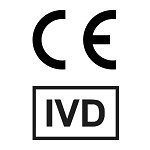-
SKU DIA-P16-OD Specificity p16 (CDKN2A)
Species Reactivity Human
Host Species Mouse
Isotype IgG1
Clone JAP16
Clonality (Mono-/Polyclonal) monoclonal
Application Immunohistochemistry (IHC), Immunohistochemistry (Paraffin-embedded Sections)
Conjugation unconjugated
Dilution Immunohistochemistry (IHC): 1:100 – 1:400
Format < 0.1% NaN3, 1% BSA, concentrate, in Tris buffer (pH 7.3-7.7), ProteinA/G purified antibody
Product line / Topic Tumor Marker / Biology
Intended Use for In vitro Diagnostic Use
Temperature - Storage 2-8°C
Temperature - Transport cooled
Search Code DIAP16, IHC, FFPE, Paraffin, p16INK4a, CDKN2A
Manufacturer / Brand dianova
Uniprot_ID Q8N726
Gene_ID 1029
Alias ARF, CDK4I, CDKN2A, CMM2, Cyclin Dependent Kinase Inhibitor 2A, Cyclin-dependent kinase 4 inhibitor A, INK4, INK4a, Melanoma P16, MLM, MTS1, Multiple tumor suppressor 1, P14ARF, P16, P16INK4a, TP16
-
dianova develops under the trademark “ONCOdianova” new antibodies for IHC detection of cancer biomarkers in FFPE-tissues.
Reactivity
Anti-p16 antibody clone JAP16 has been developed and validated for IHC detection of p16 (INK4A) tumor suppressor in routine-fixed FFPE tissue sections.
p16 is a strong negative regulator of cell proliferation and a critical tumor suppressor protein. It is the principal member of the INK4 family of cyclin-dependent kinase (CDK) inhibitors. During cell cycle progression, p16 specifically inhibits the formation of an active CDK4/6 kinase complex and thus, phosphorylation of retinoblastoma (Rb) protein. Since phosphorylation of Rb protein is a vital step for G1-to-S phase transition, p16-binding to the upstream kinase leads to cell cycle arrest.
p16 inactivation has been reported in nearly 50% of all human cancers, e.g.: head and neck, esophagus, biliary tract, liver, lung, bladder, colon and breast carcinomas, leukemia, lymphomas, glioblastomas. Besides downregulation, p16 overexpression has been observed in HPV (human papilloma virus)-related tumors such as cervical cancer. HPV oncoproteins target the p16-Rb pathway by E7 induced degradation of the retinoblastoma protein. Here, the overexpression of p16 reflects an unsuccessful attempt to stop cell proliferation in HPV-related tumors.
p16 is an important immunohistochemical (IHC) marker in gynecologic pathology.Immunohistochemistry of human p16 (INK4A) in routine formalin-fixed paraffin-embedded (FFPE) tissue samples
A: Intense nuclear p16 staining in mesenchymal components of a phyllodes tumor of breast
B: Cytoplasmic and nuclear p16 staining in a cervical adenocarcinoma
C: Diffuse positive signal for p16 in an endometrioid ovarian carcinoma
D: Intense p16 staining in a serous ovarian carcinoma(A) Phyllodes tumor of breast
B) Cervical adenocarcinoma
(C) Endometrioid ovarian carcinoma
(D) Serous ovarian carcinoma
(pictures courtesy of Prof. Guido Sauter, Department of Pathology, University Hospital Eppendorf, Hamburg, Germany)
References
- Alcorta DA et al. (1996). Involvement of the cyclin-dependent kinase inhibitor p16 (INK4a) in replicative senescence of normal human fibroblasts. Proc Natl Acad Sci USA 93: 13742–13747.
- Serrano M. (1997). The tumor suppressor protein p16INK4a. Exp Cell Res 237: 7–13.
- Milde-Langosch K et al. (2001). Overexpression of the p16 cell cycle inhibitor in breast cancer is associated with a more malignant phenotype. Breast Cancer Res Treat 67: 61–70.
- Garcia V et al. (2004). Overexpression of p16INK4a correlates with high expression of p73 in breast carcinomas. Mutat Res 554: 215–221.
- Ohtani N et al. (2003). Epstein-Barr virus LMP1 blocks p16INK4a-RB pathway by promoting nuclear export of E2F4/5. J Cell Biol 162: 173–183
- Pei XH, Xiong Y. (2005). Biochemical and cellular mechanisms of mammalian CDK inhibitors: a few unresolved issues. Oncogene 24: 2787–2795.
- Ivanova TA et al. (2007). Up-regulation of expression and lack of 5′ CpG island hypermethylation of p16 INK4a in HPV-positive cervical carcinomas. BMC Cancer 7: 47.
- Reuschenbach M et al. (2008). Characterization of humoral immune responses against p16, p53, HPV16 E6 and HPV16 E7 in patients with HPV-associated cancers. Int J Cancer 123: 2626–2631.
- Paulson TG et al. (2008). p16 mutation spectrum in the premalignant condition Barrett’s esophagus. PLoS One 3: e3809.
- Mulvany NJ et al. (2008). Diagnostic utility of p16INK4a: a reappraisal of its use in cervical biopsies. Pathology 40: 335–344.
- Lam AK et al. (2008). p16 expression in colorectal adenocarcinoma: marker of aggressiveness and morphological types. Pathology 40: 580–585.
-
p16_Cervical-adenocarcinoma p16_Endometrioid-ovarian-carcinoma p16_Phyllodes-tumor-of-breast p16_Serous-ovarian-carcinoma
Anti-p16 (CDKN2A) (Hu) from Mouse (JAP16)
Katalog-Nummer DIA-P16-OD
Size : 100µl
Marke : Dianova
Zur Verwendung in der In-vitro-Diagnostik. Nur für den professionellen Gebrauch.
Sie könnten auch an folgenden Produkten interessiert sein:
Katalog-Nummer
Beschreibung
Cond.
Preis zzgl. MwSt.





 Datasheet_DIA-P16-OD_V03
Datasheet_DIA-P16-OD_V03